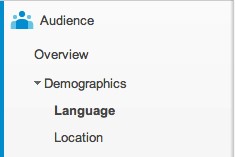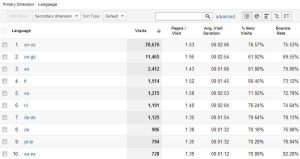Your Paid Search Language Settings Could be Costing You Money and Harming Your Brand
Are you targeting multiple languages in your paid search campaigns? If so, the language used in your ads could be sending the wrong message and costing you money. In this article, we’ll go over:
- How to make sure your language settings are configured correctly in AdWords
- Why the words used in your text ads need to jive with your customers
- How these principles can be applied to other channels

Purpose
Advertising’s purpose is to influence the behavior of consumers. Specifically, what makes a person say yes to your business, product, or service and reject the rest? In Dr. Robert Cialdini’s book Influence, he says it’s the following elements that drive us to action:
- Reciprocity: We pay back what we get from others. In marketing, this could be a free trial or a special offer.
- Scarcity: We are drawn to things that are exclusive or hard to come by. We all know the “limited time offer, space is limited” line, but we still fall for it.
- Authority: We follow people who look like they know what they’re doing. This could be identified as a seal, accreditation, or years doing business.
- Consistency: We stick with whatever we’ve already chosen. Example: rewarding customers for investing time and effort.
- Liking: We are more likely to comply with requests made by people we like. Behave like a friend, not a business.
- Consensus: We tend to trust in things that are popular or endorsed by people we know and trust. This could be a friend, celebrity endorsement, online reviews, or an expert’s opinion.
Your marketing efforts may utilize some or multiples of these, but no matter which method you choose, the language used to convey your message could undo all your efforts. Mistakes in language translation could end up sending the wrong message, and maybe even offend your prospects. Don’t accidentally harm your brand, waste your money, and miss out on potential customers. Read on to learn how.
Language can, of course, be abstracted to include multiple forms of communication. But for this exercise, let’s stay focused on the literal translations of written/spoken language.
Sh*t happens
An example of an epic translation misfire is when KFC introduced the below promotional campaign in Beijing, China. The KFC slogan, ‘Finger-lickin’ good’ was incorrectly translated in Chinese to say, ”Eat your fingers off,” leaving many with a bad taste in their mouths. Let’s not have something like this happen to you in your paid search campaigns.

AdWords detects language by the Google domain or by the default language settings. For example, Google.cn and a user within the targeted area with their default language set to Chinese will see ads targeted to Chinese. If your ads are written in English but targeting the Chinese language, there is a chance the end user may not be able to fully understand your ad.

Note for if you target Japanese, Korean, Thai, or Greek: For these languages, the alphabet characters define the language. If your campaign is in one of these, you do not need to set languages. For these languages, a keyword can trigger an ad, regardless of the user’s browser language settings.
Google Analytics: Language Report
This report shows you the number of visits and their onsite engagement stats by language.

You’ll see the ISO language codes. They represent the language and country variant. You will also see useful metrics like visits, page/visit, average duration, % new visits, and bounce rate.

Visits are the number of sessions with that language.
Page/visit is the average number of pages visited by language. Low averages are an indication that the content may not be a good fit for the language. A high average is a good sign and is what you would expect to see from a targeted language.
Average duration is the average time the user spends on your site.
% New Visits is the number of new visitors by percentage.
Bounce Rate is the percentage of users who leave the site after only hitting one page. This is a good way to gauge whether your site is working for a language. Low bounce rates are great. High bounce rates and lots of traffic may warrant an investigation.
Languages with high visits, page/visit, average durations, conversions, and low bounce rates should be targeted. If you are running campaigns targeting languages with high visits and bounce rate, then it is time to assess the damage and investigate the cause. A high bounce rate could be an indication that there is a problem with your content.
For a deeper dive, set up custom segments in Google Analytics. They are easy to set up and will allow you to view filtered data as you jump around to various reports.
Foreign Exchange: Humans Not Robots
Once you look at your data you may decide that targeting multiple languages is something you want to pursue. If that is the case, be sure to create campaigns specific to the language targeted. That means the keywords and ad copy should be written in the specific language. If you do not speak the language you might be tempted to use services like Google Translate – DON’T. Although the technology is getting better, robot translations are not always correct and may create odd wording for a native speaker.
The best practice for creating multi-language campaigns is to have a human translate your web content, ads, and keywords specifically for the language(s) you plan to target in your paid search efforts.
Search Query: https://support.google.com/adwords/answer/2472708
Search query reports are your friend. They provide so much insight into what words people are using to trigger your ads. What terms are people using to search for your business, product, or service? Make sure these terms are in your ads and in your targeted keyword list. This will ensure that you are hip the lingo driving conversions.
To wrap up, targeting multiple languages in your paid search campaigns is a great way to expand your reach to customers in your targeted area who may prefer to read their native language or only read their native language. Don’t miss these potential prospects, but proceed with caution. Make sure your translations send the message you intend to send, and your keywords make sense. Spending extra time and money to get it right will pay off dividends when you read a whole new market.



